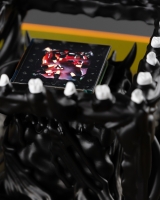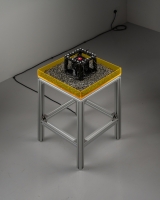Model D: Heikeji, 2023, 3D printed sculpture with embedded media display and LCD display with dynamic video loop, 28 x 26 x 25 cm
Plinth acrylic and aluminium and gravel
The term Heikeji was coined during the early decades of the 21st century, referring to the opacity in the working processes of the ever-accelerating technologies relating to AI, surveillance, and cryptography. This relic, recovered in the ruins of Neo-Shanghai, represents a now-lost application of these concepts. It's use now obscure to us, it perhaps was an aesthetic object, an evolution of the Chinese Box, representing a dark mirror to a form of Chinoiserie, in which Western views of the inscrutability of Chinese thought, culture and technology are reflected in its harsh and uncanny aggressiveness.
'The Bezos Collection: Late 21st Century Sinofuturist Chinese Art and Design'
This piece materializes contemporary concerns regarding China's opacity in the cultural discourse that trace a history from the early divinatory origins of Oracle Bone Script, to John Searle's thought experiment "the Chinese Room", to the cultural significance of the Kowloon Walled City in pop culture. If we regard language as a container for channeled information, as in the case of the Oracle Bone Script, and draw the line forward towards the formation of AI as form of sentient language, to the term Heikeji- "black technology", in which obscure, inscrutable, or highly advanced technology contains the aura of the occult, we can uncover somewhat orientalist biases that surround the question of AI in China. Formally the piece refers to black boxes, the Kowloon Walled City, as well as it's depiction in William Gibson's Idoru, in which a hole in the internet is "turned inside out" to create a temporary autonomous zone in virtual space. The black box at the heart of language/AI/China/virtuality is one which we can project any form of meaning, but remains ultimately unknowable.
Photography by Jonathan Tan


